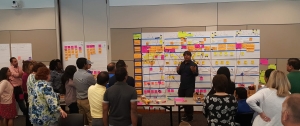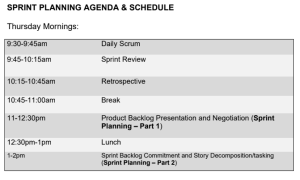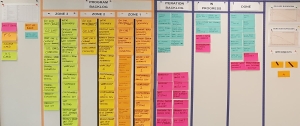Agile Project Management with Scrum: A Path to Success
Imagine you’re about to start a new project. You have a solid plan in place, but as you begin to

Cross Functional Scrum Teams
execute, you realize that there are unforeseen roadblocks and changes in the market. As a result, your project is at risk of failing. What if there was a way to adapt and pivot to these changes with ease? Enter Agile Project Management with Scrum.
In today’s fast-paced and ever-evolving world, the ability to adapt and respond to change is essential for success. The Agile Project Management approach with Scrum enables organizations to respond to change quickly and efficiently, and has revolutionized the way we work.
Agile: A Shift in Project Management Mindset
Traditionally, project management followed the Waterfall approach, where projects are planned, designed, built, and tested sequentially. However, this approach has a high failure rate because it does not accommodate changes easily. Agile Project Management with Scrum offers a different perspective.
Agile is an iterative, flexible approach to project management that encourages rapid and flexible response to change. It is a mindset that values individuals and interactions, customer collaboration, and the ability to respond to change. This mindset is perfectly embodied in the Scrum framework.
Scrum: An Agile Framework for Success
Scrum is an Agile framework that offers a simple and structured process for managing complex projects. It enables teams to deliver value incrementally, allowing for quick adaptation and continuous improvement.
Scrum Roles
In Scrum, there are three main roles:
- Product Owner: The Product Owner represents the customer and is responsible for maximizing the value of the product. They create and maintain the Product Backlog, which is a prioritized list of features, improvements, and bug fixes.Image idea: Illustration of a Product Owner managing the Product Backlog.
- Scrum Master: The Scrum Master is a servant leader who ensures that the Scrum Team follows the Scrum framework and its principles. They facilitate Scrum events, coach the team, and remove impediments.Image idea: Scrum Master coaching the Scrum Team.
- Development Team: The Development Team is a self-organizing, cross-functional group of professionals responsible for creating a potentially releasable product increment at the end of each Sprint (a time-boxed period for working on the project).

Agile Team Project Planning
Scrum Artifacts
Scrum uses three key artifacts to provide transparency and opportunities for inspection and adaptation:
- Product Backlog: A prioritized list of features, improvements, and bug fixes, managed by the Product Owner.
- Sprint Backlog: A list of items selected from the Product Backlog for the current Sprint, along with a plan for delivering them.
- Increment: The sum of all completed Product Backlog items in a Sprint, which creates a potentially releasable product.

Agenda for Scrum Events Facilitation
Scrum Events
Scrum events, or ceremonies, ensure regular inspection and adaptation:
- Sprint Planning: The Scrum Team plans the work to be done in the upcoming Sprint.
- Daily Scrum: A daily, 15-minute time-boxed event for the Development Team to synchronize their work and plan for the next 24 hours.
- Sprint Review: The Scrum Team and stakeholders inspect the Increment and adapt the Product Backlog if needed.
- Sprint Retrospective: The Scrum Team reflects on the past Sprint and identifies improvements for the next Sprint.
Implementing Scrum: A Step by Step Guide
Now that you’re familiar with the Scrum framework, let’s dive into a step-by-step guide on how to implement projects with Scrum.
Step 1: Assemble Your Scrum Team
First, identify the people who will fill the Scrum roles: Product Owner, Scrum Master, and Development Team members. The team should be cross-functional, with all the necessary skills to deliver a potentially releasable product increment.
Step 2: Create the Product Backlog
The Product Owner creates the Product Backlog by identifying and prioritizing features, improvements, and bug fixes based on the needs of the customer and business. The Product Backlog is a living document that evolves as the project progresses.

Mark Palmer’s Product Backlog Model (PAIR)
Step 3: Plan the Sprint
During Sprint Planning, the Scrum Team collaboratively decides which items from the Product Backlog will be included in the upcoming Sprint. The Development Team then creates a plan for delivering the selected items, creating the Sprint Backlog.
Step 4: Execute the Sprint
The Development Team works on the Sprint Backlog items during the Sprint, which typically lasts two to four weeks. The team meets daily for the Daily Scrum to coordinate their work and address any impediments.
Step 5: Inspect and Adapt
At the end of the Sprint, the Scrum Team and stakeholders attend the Sprint Review to inspect the Increment and adapt the Product Backlog as needed. This is followed by the Sprint Retrospective, where the Scrum Team identifies improvements for the next Sprint.

Sprint Review
Step 6: Repeat the Process
The Scrum process is iterative, and the team will continue to plan, execute, inspect, and adapt through subsequent Sprints until the project is complete or the Product Owner decides to release the product.
The Benefits of Agile Project Management with Scrum
By embracing the Agile mindset and using the Scrum framework, organizations can reap numerous benefits:
- Higher customer satisfaction: Agile Project Management with Scrum focuses on delivering value to the customer in small, frequent increments, ensuring the product evolves to meet their needs.
- Increased transparency and collaboration: Scrum artifacts and events provide transparency and opportunities for collaboration, leading to better decision-making and a more cohesive team.
- Reduced risk: Incremental delivery and regular inspection reduce the risk of project failure, as changes can be quickly identified and addressed.
- Greater adaptability: The iterative nature of Scrum allows organizations to respond to changes in the market or customer needs, making them more competitive and resilient.
In conclusion, Agile Project Management with Scrum offers a flexible, adaptive, and collaborative approach that empowers teams to deliver high-quality products while responding to change. By following the step-by-step guide outlined above and embracing the Agile mindset, you can set your projects on the path to success.


